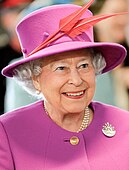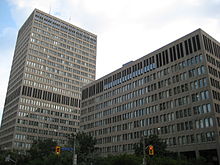Government of Ontario
| Constitutional monarchy | |
 Coat of arms of Ontario, used across the government (left); and the Ontario wordmark, used to corporately identify the executive (right) | |
| Formation | 1 July 1867 |
|---|---|
| Founding document | Constitution Act, 1867 |
| Country | Canada |
| Website | www |
| Crown | |
| Sovereign | Monarch (Queen Elizabeth II) |
| Vice-regal representative | Lieutenant Governor (Elizabeth Dowdeswell) |
| Legislative (Crown-in-Parliament) | |
| Legislature | Provincial Parliament (Legislative Assembly) |
| Meeting place | Ontario Legislative Building, Queen's Park |
| Executive (Crown-in-Council) | |
| Head of government | Premier (Doug Ford, Jr.) |
| Main organ | Executive Council of Ontario (Cabinet) |
| Judicial (Crown-on-the-Bench) | |
| Court | Court of Appeal for Ontario (highest court) |
 |
|---|
| Crown |
|
| Provincial legislature |
|
| Government |
| See also |
| Politics by province / territory |
|
|
The Government of Ontario (French: Gouvernement de l'Ontario), formally Her Majesty's Government of Ontario,[1] is the body responsible for the administration of the Canadian province of Ontario. A constitutional monarchy, the Crown—represented in the province by the lieutenant governor—is the corporation sole, assuming distinct roles: the executive, as the Crown-in-Council; the legislature, as the Crown-in-Parliament; and the courts, as the Crown-on-the-Bench. The functions of the government are exercised on behalf of three institutions—the Executive Council; the Provincial Parliament (Legislative Assembly); and the judiciary, respectively. Its powers and structure are partly set out in the Constitution Act, 1867.
The term Government of Ontario (French: Gouvernement de l'Ontario) refers specifically to the executive—political ministers of the Crown (the Cabinet/Executive Council), appointed on the advice of the premier, and the non-partisan Ontario Public Service (whom the Executive Council directs), who staff ministries and agencies to deliver government policies, programs, and services—which corporately brands itself as the Government of Ontario, or more formally, Her Majesty's Government of Ontario (French: Gouvernement de l’Ontario de Sa Majesté).[2]
Owing to the location of the Ontario Legislative Building on the grounds of Queen's Park, the Ontario government is frequently referred to by the metonym "Queen's Park".[3]
The Crown[]
Queen Elizabeth II, as monarch of Canada is also the Queen of Ontario. As a Commonwealth realm, the Canadian monarch is shared with 15 other independent countries within the Commonwealth of Nations.[9] Within Canada, the monarch exercises power individually on behalf of the federal government, and the 10 provinces.

Elizabeth II is Queen of Canada, the head of state

Elizabeth Dowdeswell is Lieutenant Governor, representing the monarch in Ontario
Lieutenant Governor[]
The powers of the Crown are vested in the monarch and are exercised by the lieutenant governor. The advice of the premier and Executive Council is typically binding; the Constitution Act, 1867 requires executive power to be exercised only "by and with the Advice of the Executive Council".[10]
Powers and function[]
The lieutenant governor is appointed by the governor general, on the advice of the prime minister of Canada.[14] Thus, it is typically the lieutenant governor whom the premier and ministers advise, exercising much of the royal prerogative and granting royal assent.
While the advice of the premier and Executive Council is typically binding on the lieutenant governor, there are occasions when the lieutenant governor has refused advice. This usually occurs if the premier does not clearly command the confidence of the elected Legislative Assembly.
Federally, a notable instance occurred in 1926, known as the King-Byng Affair, when Governor General Lord Byng of Vimy refused Prime Minister Mackenzie King's request to dissolve the federal Parliament to call for a general election. More recently, on a provincial level in 2017 following the provincial election in British Columbia, Premier Christy Clark met with Lieutenant Governor Judith Guichon and advised dissolution of the Legislature. Guichon declined the Clark's request. Clark then offered her resignation as Premier, and the leader of the Official Opposition, John Horgan, who was able to command the confidence of the elected Legislature, was invited to form government.[15]
Executive power[]

The executive power is vested in the Crown and exercised "in-Council", meaning on the advice of the Executive Council; conventionally, this is the Cabinet, which is chaired by the premier and comprises ministers of the Crown. The term Government of Ontario, or more formally, Her Majesty's Government refers to the activities of the Lieutenant Governor-in-Council. The day-to-day operation and activities of the Government of Ontario are performed by the provincial departments and agencies, staffed by the non-partisan Ontario Public Service and directed by the elected government.
Premier[]
The premier of Ontario is the first minister of the Crown. The premier acts as the head of government for the province, chairs and selects the membership of the Cabinet, and advises the Crown on the exercise of executive power and much of the royal prerogative. As premiers hold office by virtue of their ability to command the confidence of the elected Legislative Assembly, they typically sit as a MPP and lead the largest party or a coalition in the Assembly. Once sworn in, the premier holds office until their resignation or removal by the lieutenant governor after either a motion of no confidence or defeat in a general election.[16]
In Canada, the Cabinet (French: Conseil des ministres, lit. 'council of ministers') of provincial and territorial governments are known as an Executive Council (French: Conseil exécutif).
The premier of Ontario is Doug Ford of the Progressive Conservatives since the 2018 election; the 26th since Confederation.
Ministries[]

- Ministry of Agriculture, Food, and Rural Affairs
- Ministry of the Attorney General
- Ministry of Children, Community and Social Services
- Ministry of Colleges and Universities
- Ministry of Economic Development, Job Creation and Trade
- Ministry of Education
- Ministry of Energy, Northern Development, and Mines
- Ministry of the Environment, Conservation and Parks
- Ministry of Finance
- Ministry of Francophone Affairs
- Ministry of Government and Consumer Services
- Ministry of Health
- Ministry of Heritage, Sports, Tourism and Culture Industries
- Ministry of Indigenous Affairs
- Ministry of Infrastructure
- Ministry of Intergovernmental Affairs
- Ministry of Labour, Training and Skills Development
- Ministry of Long Term Care
- Ministry of Municipal Affairs and Housing
- Ministry of Natural Resources and Forestry
- Ministry of Seniors and Accessibility
- Ministry of the Solicitor General
- Ministry of Transportation
- Treasury Board Secretariat
Crown corporations[]
Legislative power[]

The unicameral 124-member Legislative Assembly of Ontario (French: Assemblée législative de l'Ontario), and the Crown-in-Parliament (represented by the lieutenant governor) comprise the Provincial Parliament of Ontario. As government power is vested in the Crown, the role of the lieutenant governor is to grant royal assent on behalf of the monarch to legislation passed by the Legislative Assembly. The Crown does not participate in the legislative process save for signifying approval to a bill passed by the Assembly.
Membership[]
Officeholders, known as members of Provincial Parliament (MPPs) are elected using the first-past-the-post system.
Government[]
The legislature plays a role in the election of governments, as the premier and Cabinet hold office by virtue of commanding the body's confidence. Per the tenants of responsible government, Cabinet ministers are almost always elected MPPs, and account to the Legislative Assembly.
Opposition[]
The second largest party of parliamentary caucus is known as the Official Opposition, who typically appoint MPPs as critics to shadow ministers, and scrutinize the work of the government.
The Official Opposition is formally termed Her Majesty's Loyal Opposition, to signify that, though they may be opposed to the premier and Cabinet of the day's policies, they remain loyal to Canada, which is personified and represented by the Queen.[17]
Judiciary[]
| Court | Type | Composition method | Notes |
|---|---|---|---|
| Court of Appeal for Ontario | Appellate court | Selected federally | Appeals to the Supreme Court of Canada |
| Court of Ontario | Trial court | Selected federally (Superior Court of Justice)
Selected provincially (Court of Justice) |
The Court of Ontario comprises the Superior Court of Justice and the Court of Justice |
| Provincial boards, commissions and tribunals | Tribunal | Selected provincially | For example: Ontario Human Rights Tribunal, or Social Justice Tribunals Ontario (SJTO), which comprises eight bodies including the Landlord and Tenant Board, Child and Family Services Review Board, and others |
See also[]
- Association of Management, Administrative and Professional Crown Employees of Ontario
- Cabinet of Ontario
- Ontario Public Service Employees Union
- Politics of Ontario
References[]
- ^ "Order in Council 1681/2016". Government of Ontario. 2017-01-03.
PURSUANT TO the prerogative of Her Majesty The Queen in Right of Ontario to appoint advisors to serve Her Majesty's Government of Ontario in the discharge of its executive obligations and responsibilities...
- ^ "Order in Council 174/2019". www.ontario.ca. Retrieved 2021-03-28.
- ^ "Legacy of a People's Park". Education Portal. Legislative Assembly of Ontario. Archived from the original on 21 January 2015. Retrieved 21 January 2015.
- ^ Claude Bouchard (16 February 2016). "Jugement No. 200-17-018455-139" (PDF) (in French). Cour supérieure du Québec. p. 16. Retrieved 17 February 2016 – via Le Devoir.
- ^ Romaniuk, Scott Nicholas; Wasylciw, Joshua K. (February 2015). "Canada's Evolving Crown: From a British Crown to a "Crown of Maples"". American, British and Canadian Studies Journal. 23 (1): 108–125. doi:10.1515/abcsj-2014-0030.
- ^ Department of Canadian Heritage (2015). "Crown of Maples: Constitutional Monarchy in Canada" (PDF). Her Majesty the Queen in Right of Canada. p. 3. Archived from the original (PDF) on 10 November 2012. Retrieved 16 February 2016.
- ^ "Queen and Canada". The Royal Household. Retrieved 16 February 2016.
- ^ "The Queen of Canada". Government of Canada. Archived from the original on 24 February 2016. Retrieved 16 February 2016.
- ^ [4][5][6][7][8]
- ^ Branch, Legislative Services (2020-08-07). "Consolidated federal laws of canada, THE CONSTITUTION ACTS, 1867 to 1982". laws-lois.justice.gc.ca. Retrieved 2021-04-03.
- ^ Hicks, Bruce (2012). "The Westminster Approach to Prorogation, Dissolution and Fixed Date Elections" (PDF). Canadian Parliamentary Review. 35 (2): 20.
- ^ McLeod 2008, p. 36
- ^ Government of Canada (4 December 2015). "Why does the Governor General give the Speech?". Queen's Printer for Canada. Archived from the original on 26 April 2018. Retrieved 17 December 2015.
- ^ [11][12][13]
- ^ "Lieutenant Governor". www.leg.bc.ca. Retrieved 2021-03-29.
- ^ Brooks 2007, p. 235
- ^ Schmitz, Gerald (December 1988), The Opposition in a Parliamentary System, Ottawa: Queen's Printer for Canada, archived from the original on 25 April 2009, retrieved 21 May 2009
- ^ Ontario Courts, maintained by the Judges' Library. "Introduction to Ontario's Courts | Ontario Court of Justice". Retrieved 2021-03-31.
- ^ Ontario Courts, maintained by the Judges' Library. "Canada's Court System | Ontario Court of Justice". Retrieved 2021-03-31.
- ^ "What is the court system in Ontario?". settlement.org. Retrieved 2021-03-31.
- ^ "The Courts in Ontario - Ministry of the Attorney General". www.attorneygeneral.jus.gov.on.ca. Retrieved 2021-03-31.
External links[]
- Government of Ontario



